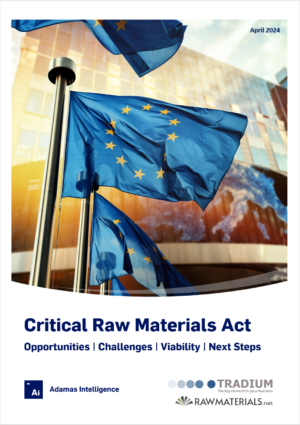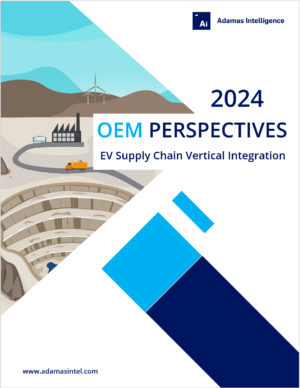Weekly Lithium Lowdown with Chris Williams – Week 5, 2024

Greenbushes cuts spodumene output, updates offtake pricing
Greenbushes’ JV partner IGO confirmed this week a much-anticipated sales volume cut from the world’s premier Western Australian spodumene mine.
In response to falling lithium chemical demand and prices, guidance for FY2024 sales were lowered to 1.3-1.4 Mt (from 1.4-1.5 Mt) of SC6. Despite this, the JV remains committed to completing the CGP3 plant which would add 500 ktpa SC6 capacity in 2025.
Further, a new monthly pricing mechanism for offtake was agreed, which will replace existing quarterly pricing. An average price basket will be used, less a 5% volume discount, FOB Australia.
The Kemerton lithium hydroxide refinery remains operational at 10% of design capacity, having produced only 617t LiOH.H2O in the quarter.
Adamas take: Annualised, the ~100 kt SC6 reduction in half-year sales translates to roughly 28 kt LCE of mined chemical grade supply, or ~2% of 2024E supply. The curtailment will go a long way in balancing the market in 2024 though is certainly not a market mover in and of itself.
Mineral Resources delivers solid outcomes at WA lithium assets
Mineral Resources recently announced a 30% increase in Q2 FY24 spodumene concentrate production from the Mt. Marion mine in Western Australia. 166 kt of production was achieved grading 4.2% Li2O, “driven by higher utilization of the plant and improved ore recoveries from a higher volume of fresh ore”. Much of the mine’s past production was at the 3.7% Li2O level.
Also unveiled was the first figures of Bald Hill’s production since MinRes’ November 1, 2023, acquisition. 26 kt grading 5.4% was produced for the 2 months reported, with cost guidance to be provided in the upcoming half-year results.
Wodgina is expected to significantly reduce FOB costs from A$845/t to A$550/t by September 2024 as feed quality improves and the strip ratio declines.
Adamas take: If Mt. Marion can stay within fresh rock it will comfortably generate cash, like the Wodgina asset has done. Without higher fractions of fresh rock (>50%) Mt. Marion could become a marginal producer on an AISC basis. Bald Hill appears on track given its production rate is just shy of previous guidance of 145 ktpa SC6.
Sayona endures a tough quarter as strategic review sets in
Sayona Mining, operator of Quebec’s NAL mine, announced last week outcomes of its ongoing strategic reviews, which sees the departure of CEO Guy Belleau among 14 other colleagues.
The mine, which re-sparked hopes of some North American lithium supply security, is operating at 58% nameplate capacity according to the Q4 CY2024 report. Accordingly, unit costs came in at $918 FOB Quebec, 48% higher than realized selling prices and 14% higher than previous quarter.
Lithia recovery has trended up from 43% at March to 66% in December 2023 as a range of ramp-up optimizations took effect.
Adamas take: The previously mothballed operation from 2018-2019, restarted in 2023, remains a swing producer at the troughs of these lithium cycles and is currently under threat of going into care and maintenance, again. Current cash of A$158M gives a 2-quarter runway at current burn rate. It is likely to take a significant re-tooling to make this asset profitable. The high iron content and dilution from thin seams lend to high production costs. Further, the JV deal struck with Piedmont Lithium meant Sayona were less able to capitalize on high lithium prices, which it encountered briefly in 2023.
AVZ Minerals upgrades Manono MRE to 842 Mt
AVZ Minerals released an updated MRE for the Manono project in the DRC this week.
268 Mt of resource was added to the Roche Dure deposit, bringing the global Manono resource base to 842 Mt grading 1.61% Li2O (0.5% Li2O cutoff), containing 33.4 Mt of LCE. For comparison, Greenbushes’ resource contains 13.9 Mt LCE. 500 Mt, or 59% of Manono’s total resource is in the M&I categories.
The resource update derives from a 53 drill holes program from 2022 and 2023 which totaled 15,685m, yielding of 18 Mt/km. The additional tonnes are expected to improve on the 2020 DFS defined 20-yr mine life and 0.48 waste-to-ore strip ratio.
The company is currently in arbitration over project ownership disputes. AVZ’s securities have remained in a trading halt since May 2022.
Adamas take: The update serves a reminder of what’s at stake in the ongoing legal proceedings: the fate of the most globally significant spodumene resource.
Sigma adds 27% to Grota do Cirilo MRE
Sigma Lithium this week released an updated MRE for its Grota do Cirilo mine in Minas Gerais, Brazil.
23.4 Mt of resource was added, bringing the global Grota do Cirilo resource base to 109 Mt grading 1.39% Li2O (0.3% Li2O cutoff), containing 3.8 Mt of LCE. 93.4 Mt, or 86% of Sigma’s total resource is in the M&I categories.
The drill program allows mine planners to conceptualize the NDC and Murial deposits into a single open pit for Phase 3 & 4 of development.
The company currently operates 8 drill rigs and eyes a 150 Mt resource target.
Adamas take: The resource upgrade is timely for Sigma given its currently marketing for a takeover. What started as a modest 20 Mt deposit at Xuxa (13m thick pegmatite, dipping 50° over 1,700m strike), has grown to an impressive field of pegmatite dykes further south, allowing expansion optionality prospective suitors look for.
Chris Williams, Analyst at Adamas Intelligence
Chris is an Analyst at Adamas Intelligence focused on the global lithium industry. He researches and analyzes the lithium value chain to uncover actionable opportunities for clients.
Chris has 11-years experience in mining and oil & gas operations optimization, delivering value from data intensive insight generation. He completed his Bachelor and Masters of Engineering at the University of Queensland, majoring in Mechanical Engineering, and is currently completing a Masters of Business Administration at the University of British Columbia.
EV, Battery and Battery Materials Market Intelligence:
EV Battery Capacity and Battery Metals Tracker
Building on ongoing EV registrations in over 110 countries, our web-based platform helps users track monthly deployment of battery metals and materials, battery capacity, and the ever-evolving competitive landscapes of battery chemistries and cell suppliers.
EV Battery Capacity Monthly
The ‘EV Battery Capacity Monthly’ is a subscription-based report for tracking monthly deployment of passenger EV battery capacity by EV type, region, country, make, model, cell supplier and cell chemistry on an ongoing basis.






